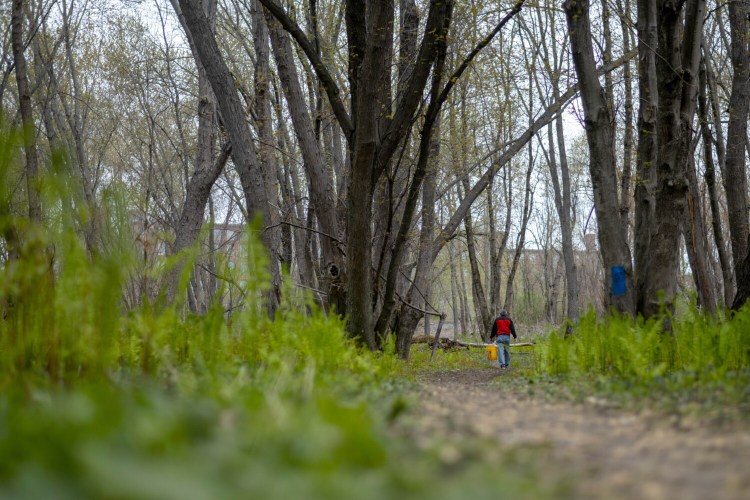Individually and as a group, people would be healthier if we lived as hunter-gatherers instead of depending for our food on cultivated crops, Arthur Haines told a group gathered at Maine Audubon Society’s Gilsland Farm in Falmouth earlier this month.
Haines is senior botanist at the Native Plant Trust – formerly the New England Wild Flower Society – based in Framingham, Massachusetts. He is the author of “Flora Novae Angliae,” a taxonomy of all the plants growing in New England. He also teaches classes in foraging and primitive living, and with his wife has helped form Wilder Waters Community, working to protect a wilderness area near the Androscoggin River in Canton.
“I would make the case that we are not eating our biologically proper diet,” he said. “If we foraged for our food, we would be better off.”
Haines said the idea that hunter-gatherers died young is false. If you discount those who died in childhood, people in the late Stone Age lived, on average, into their 70s, and they didn’t suffer from many of the diet-related diseases people experience today, including dental cavities, lower bone density and chronic disease.
But a hunter/gatherer society is no longer possible, and not only because most people no longer know how to forage. Today, just 3 percent of the Earth’s surface is wilderness; foraging could never support the planet’s 7.9 billion (and counting) people.
Earth is able to support this massive number because of a single invention, Haines said. More than a century ago, scientists invented the Haber-Bosch process, which can pull nitrogen – the most important ingredient in modern chemical fertilizers – from the air. The machine provides 50 percent of the nitrogen found in human bodies, Haines said. The use of artificial fertilizer allows humans to grow enough food to feed the planet’s billions.
As a side effect, the population explosion contributes to climate change.
Another problem for people’s health, Haines said, is that modern people eat different plants than our foraging ancestors did, in that the plants we eat have been genetically modified. He used the term “modified” to include traditional hybrids (where scientists cross different plants in the same species to get certain desirable characteristics), as well as the genetically modified organisms, or GMOs, that are created in laboratories (where genes are inserted into plants where they do not naturally exist).

Yes, cauliflower is good for you. But not nearly as good for you as its wild ancestors, according to botanist Arthur Haines. Sun Journal file photo
Take, for example, brassicas, a plant native to Europe, Asia and the Mediterranean that used to be foraged. Over the centuries, brassicas were hybridized by plant scientists and farmers, a process that created broccoli, Brussels sprouts, bok choy, turnips, cauliflower and other commonplace modern vegetables. All are good, Haines said, but not as healthy for humans as the original.
To improve their health, people today should harvest – either through agriculture or foraging – and eat foods that are closer to the wild originals, like wild low-bush blueberries, for example. Grown in the state’s blueberry barrens and found on many mountain ridges, low-bush blueberries provide more nutrition than cultivated high-bush varieties. That’s because most of the vitamins are in the skin, and the smaller wild berries have a higher percentage of skin than the cultivated berries do.
Likewise, fox grapes, which are native to Maine, are healthier than cultivated grapes because people eat their seeds, which contain much of the nutrition. Ground nuts, a native legume, are similar to but healthier than both potatoes and sweet potatoes. Wild rice, native to the northern Midwest, is healthier than Asian rice, especially after the rice is processed to remove the husk, bran and germ to make it white. Hips from rugosa roses (yes, they are on some invasive-plant lists but regardless they grow all over Maine’s coast) have more vitamin C than oranges. Many berries – including raspberries, blackberries and strawberries – are healthier in their wild form than they are cultivated in your garden.
Another reason Haines wouldn’t want everyone to suddenly start foraging is that many people now, unlike the Indigenous people in the past, go too far, picking too much and depleting wild stands. “We are like bands of locusts that consume everything in our path,” he said.
But there are ways to forage that don’t harm, and may even improve, the wilderness. When people tap a maple tree properly, they get a sap harvest without hurting the tree. Harvesting acorns or other fallen nuts won’t hurt the trees, either. Harvesters typically miss many seeds, inadvertently spreading them, Haines said, which helps the plants increase their range.
So putting a bubble over the wilderness and keeping people out is not the right way to conserve the wilderness, he said. Better to let people in, but ensure that they harvest wild plants and do other outdoor activities in ways that sustain, not threaten, the wilderness.
Tom Atwell is a freelance writer gardening in Cape Elizabeth. He can be contacted at: tomatwell@me.com.
Send questions/comments to the editors.



Success. Please wait for the page to reload. If the page does not reload within 5 seconds, please refresh the page.
Enter your email and password to access comments.
Hi, to comment on stories you must . This profile is in addition to your subscription and website login.
Already have a commenting profile? .
Invalid username/password.
Please check your email to confirm and complete your registration.
Only subscribers are eligible to post comments. Please subscribe or login first for digital access. Here’s why.
Use the form below to reset your password. When you've submitted your account email, we will send an email with a reset code.